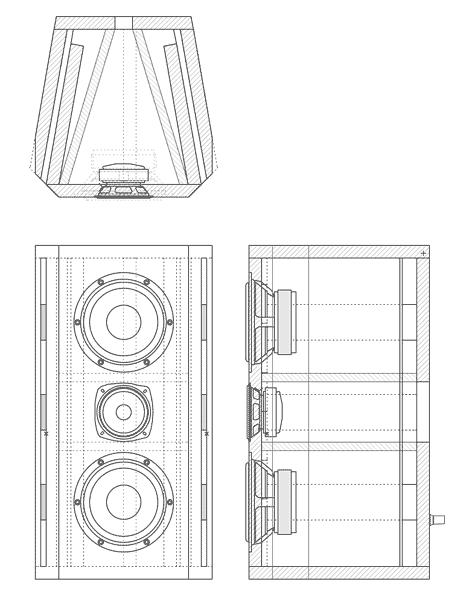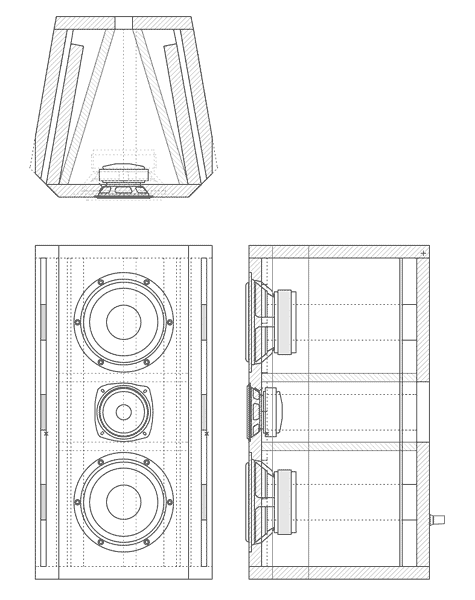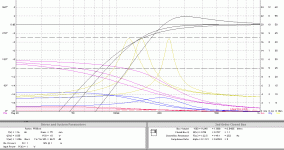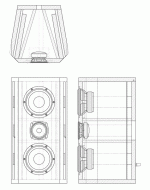What is the best way, aside perhaps from using a filter, to prevent a small full range driver, such as the Fostex FF85WK from overextending itself?
Open baffle, or small sealed box, say 1 Liter to provide back pressure?
The idea is to prevent any bass from emitting from it, or the driver making any effort to reproduce same.... wondering if it is possible just with enclosure design (or lack thereof in the case of OB) without a capacitor inline....or is a capacitor the only way.... I can't use an active filter.... thanks!
The goal would be to allow said driver to handle loud rock music if required.
Open baffle, or small sealed box, say 1 Liter to provide back pressure?
The idea is to prevent any bass from emitting from it, or the driver making any effort to reproduce same.... wondering if it is possible just with enclosure design (or lack thereof in the case of OB) without a capacitor inline....or is a capacitor the only way.... I can't use an active filter.... thanks!
The goal would be to allow said driver to handle loud rock music if required.
Thanks Dave! I thought an active filter goes in between the preamp and the amp... as mentioned I, unfortunately, can't use an active filter (because the source is a receiver without pre outs and fed via HDMI).
So, looks like a passive filter (a cap at least and maybe an inductor for 2nd order), or, the small sealed box, which would hopefully prevent damage to the driver just as well as the filter (?).
I see on your screenshot you modeled at 0.34 liters... gosh, that's small. And, I don't know if the hump around 300 Hz would be problematic in practice (?). So many questions.
So, looks like a passive filter (a cap at least and maybe an inductor for 2nd order), or, the small sealed box, which would hopefully prevent damage to the driver just as well as the filter (?).
I see on your screenshot you modeled at 0.34 liters... gosh, that's small. And, I don't know if the hump around 300 Hz would be problematic in practice (?). So many questions.
Problem is the bass power would still reach the coil in the driver. It would only be made into heat instead of sound. So you'd have to choose a driver that could take the punishment and you wouldn't be able to play as loud as with a filter.
I'd be interested to hear/see if anyone has actually made a setup augmented with bass drivers like this (nonfiltered).
I'd be interested to hear/see if anyone has actually made a setup augmented with bass drivers like this (nonfiltered).
Thanks Dave! I thought an active filter goes in between the preamp and the amp... as mentioned I, unfortunately, can't use an active filter (because the source is a receiver without pre outs and fed via HDMI).
Put the cap in the tape loop.
So, looks like a passive filter (a cap at least and maybe an inductor for 2nd order), or, the small sealed box, which would hopefully prevent damage to the driver just as well as the filter (?).
After the amp before the speaker is not very effective because of the rise in impedance at resonance.
I see on your screenshot you modeled at 0.34 liters... gosh, that's small. And, I don't know if the hump around 300 Hz would be problematic in practice (?). So many questions.
I would target 0.707 Q or a bit higher.
dave
It would only be made into heat instead of sound. So you'd have to choose a driver that could take the punishment and you wouldn't be able to play as loud as with a filter.
That much heat could be a problem in such a small sealed space made out of wood.
Most full range drivers can't take much punishment which is why I'm thinking about this at all.
However, I firmly believe "less is more" with audio in general, thus hoping someone has tried an unfiltered full ranger in a small cabinet or some other creative enclosure to curtail it sufficiently to do a FAST of sorts without a filter on the FR. I know most FAST use bi-amping with an active filter before the amps. However, I can't do that.
I know most FAST use bi-amping with an active filter before the amps. However, I can't do that.
Bi-amping just makes it easier. In our original FF85k + 2 x EL166 the goal was passive all the way and we achieved results beyond expectation.
The current project is uFonkenSET + twin Peerless woofT. It works great bi-amped, working on the passive.
The same will be true of our latest, a passive XO.
If you are doing a FAST you don't need to worry about producing bass,
One of the keys is to get the XO high enuff. The original MTM was about 350 Hz with the FF85s resonance peak heavily attentuated by an aperiodic TL, the same line is being used in effort 3.
There is a trade-off. Sealed produces a natural 2nd order (with the FF85 lower than you'd like) but any passive has to deal with a big peak. Aperiodic flattens the impedance but the filter can work better. If well done it also has advantages wrt reducing boxy colourations.
dave
Attachments
I remember you showing a before and after of the Fs peak with sealed and aperiodic, Dave. Was really slick. I gotta leane how to do that.
Ben, as Dave has been saying, the impedance resonance peak of these fostex are quite high q and magnitude. A single cap doesn't offer much power handling right as the peak because the cap is ineffective at such high impedances. In the only FAST I've ever done, I was pushed into 2nd order on the FE83eN. I don't know any of the fancy box work to alleviate this issue.
Alternatively to 2nd order you can use an LCR impedance compensation network if really stuck on 1st order. But this is more parts, more complex, more expensive, and less power handling. It would be a true 6db/oct transfer function though. Combined with sealed roll off may be 18db.
Ben, as Dave has been saying, the impedance resonance peak of these fostex are quite high q and magnitude. A single cap doesn't offer much power handling right as the peak because the cap is ineffective at such high impedances. In the only FAST I've ever done, I was pushed into 2nd order on the FE83eN. I don't know any of the fancy box work to alleviate this issue.
Alternatively to 2nd order you can use an LCR impedance compensation network if really stuck on 1st order. But this is more parts, more complex, more expensive, and less power handling. It would be a true 6db/oct transfer function though. Combined with sealed roll off may be 18db.
I remember you showing a before and after of the Fs peak with sealed and aperiodic, Dave. Was really slick. I gotta leane how to do that.
Original Tysen, IIRC.

One of the keys is to get the XO high enuff. The original MTM was about 350 Hz with the FF85s resonance peak heavily attentuated by an aperiodic TL, the same line is being used in effort 3.
dave
Thanks for the responses guys (Dave).... I have a question about that design you pictured.... it looks as though the chamber for the FF85 is open at the back? I assume you are heavily stuffing that small space to make it aperiodic? Or is it more complex than that?
You are also correct that 200 Hz on the lower end is lower than I'd like... 300-400 would be better. Can the small aperiodic space achieve that or are we still needing a filter?
Any drivers better than FF85 for this application? I.e., still offering "the best" mids and highs but higher acoustic roll off?
Is the heat dissipation issue with the amp bass power still being applied too much for safety?
Thanks again.
Thanks for the responses guys (Dave).... I have a question about that design you pictured.... it looks as though the chamber for the FF85 is open at the back? I assume you are heavily stuffing that small space to make it aperiodic? Or is it more complex than that?
Progressive density of the fill and the pronounced taper of the chamber is what we used with the FF85K in Tysen, as well as the MTM with CSS EL166 mid-woofs - it worked out well enough in both cases. IINM the measured curves to which Ryan referred were for the Tysen?
Thanks for the responses guys (Dave).... I have a question about that design you pictured.... it looks as though the chamber for the FF85 is open at the back? I assume you are heavily stuffing that small space to make it aperiodic? Or is it more complex than that?
Yes, Yes (but not uniformly and not all the same material), No.
Can the small aperiodic space achieve that or are we still needing a filter?
Aperiodic gives up an order to sealed and needs the filter... it is just that the filter is more effective. The aperiodic line also "sucks" the back wave away so you get less time-smeared reflection back thru the cone cleaning up the midrange.
Any drivers better than FF85 for this application? I.e., still offering "the best" mids and highs but higher acoustic roll off?
Alpair 6.2m offers similar performance, it won't give a higher acoustic rolloff, but goes lower, with a smaller peak at resonance. Higher bass output capability means that it has more room to move before overextending itself.
Is the heat dissipation issue with the amp bass power still being applied too much for safety?
No more than in any other application. You have to play pretty loud to start a fire.
dave
You have to play pretty loud to start a fire.
dave
That gave me a chuckle.
Thanks again for all of the great info, more to think about!
Most full range drivers can't take much punishment which is why I'm
thinking about this at all.
However, I firmly believe "less is more" with audio in general, thus hoping
someone has tried an unfiltered full ranger in a small cabinet or some other
creative enclosure to curtail it sufficiently to do a FAST of sorts without a
filter on the FR. I know most FAST use bi-amping with an active filter
before the amps. However, I can't do that.
Hi,
So just build a FAST with a minimum 1st order series x/o.
Will solve excursion problems in one stroke.
250 to 400Hz, depending on baffle width, bass driver size.
Triangulate the top of the box for the FR, or front to back tube.
rgds, sreten.
Hi,
So just build a FAST with a minimum 1st order series x/o.
Will solve excursion problems in one stroke.
250 to 400Hz, depending on baffle width, bass driver size.
Triangulate the top of the box for the FR, or front to back tube.
rgds, sreten.
like this:?

P10, chris, Sreten- Am I correct in thinking that a 1st order series filter is best suited for the OP? In comparison to a parallel 1st order network.
This has been our experience. And it is the one kind of XO that has at least one advantage over any active XO.
dave
Yep, series first order XOs are nice in that they compensate for impedance changes, resulting in a flat response again (albeit with the XO point and Q altered slightly).
I'd expect the benefits of taking the LF duties off the smaller driver would outweigh the downsides of a simple XO.
Chris
I'd expect the benefits of taking the LF duties off the smaller driver would outweigh the downsides of a simple XO.
Chris
- Status
- This old topic is closed. If you want to reopen this topic, contact a moderator using the "Report Post" button.
- Home
- Loudspeakers
- Full Range
- Prevent Small Full Range Driver From Overextending Itself

